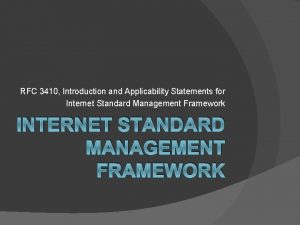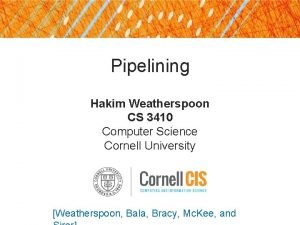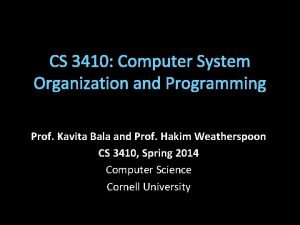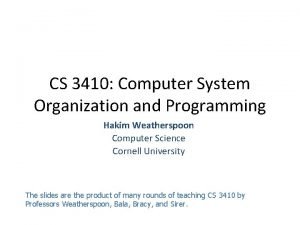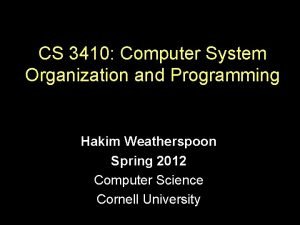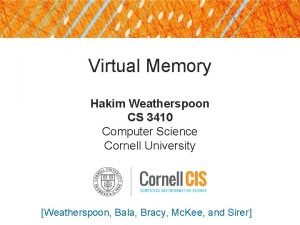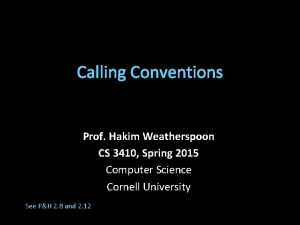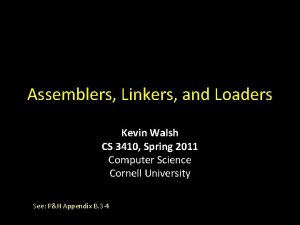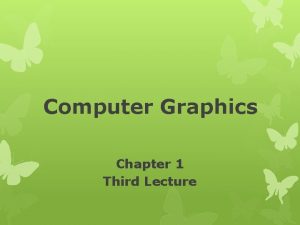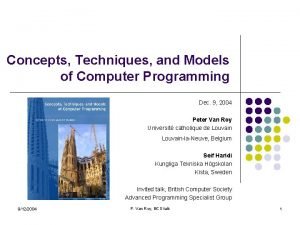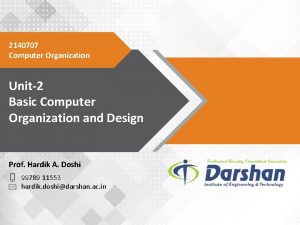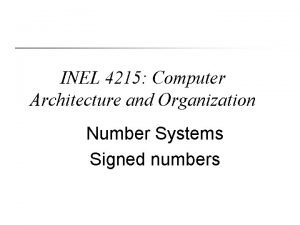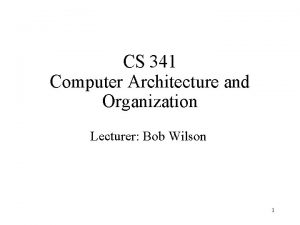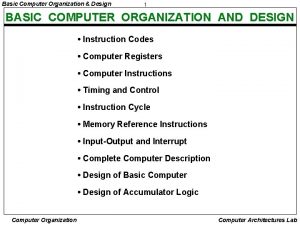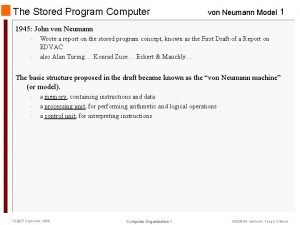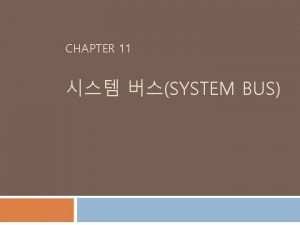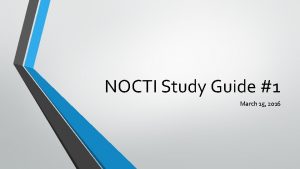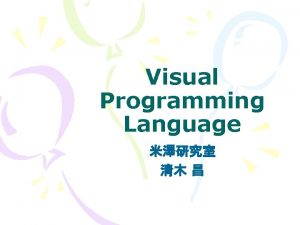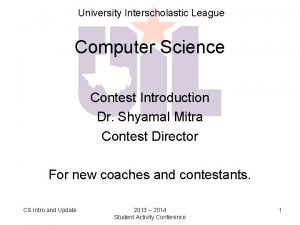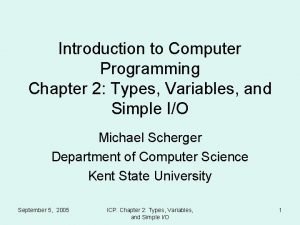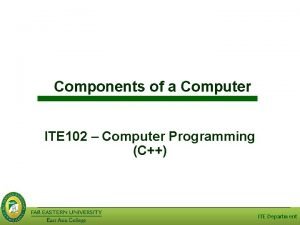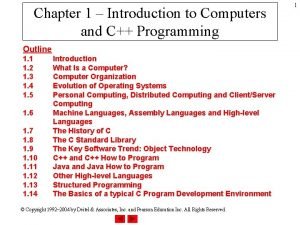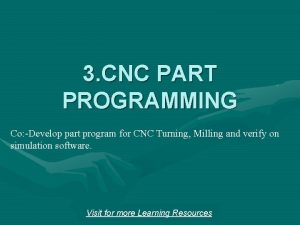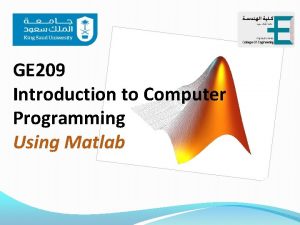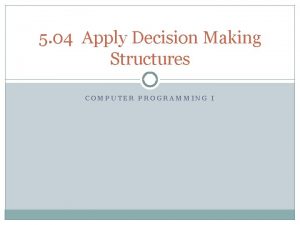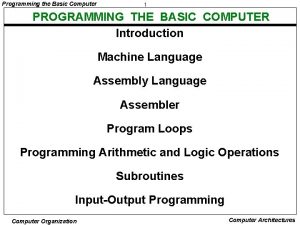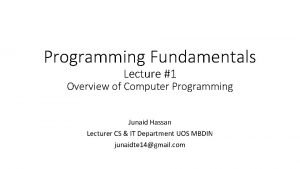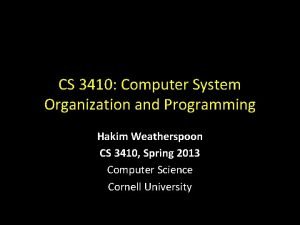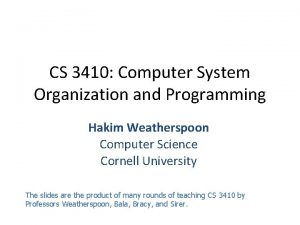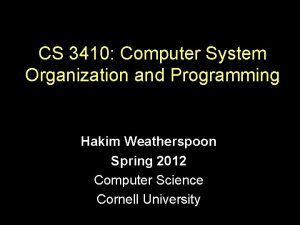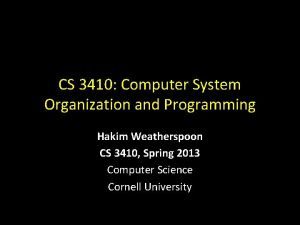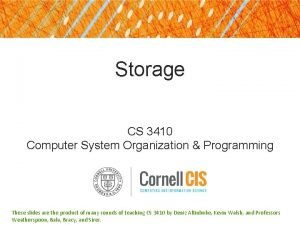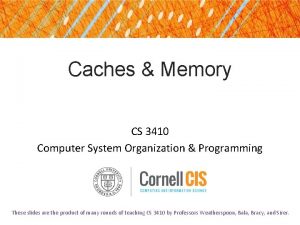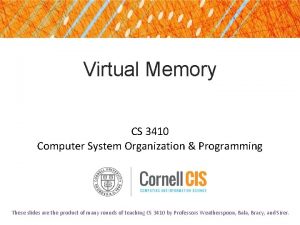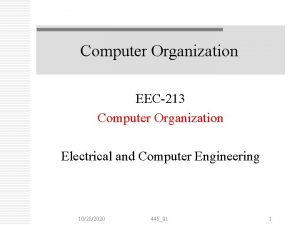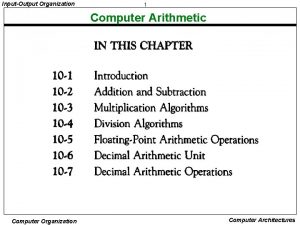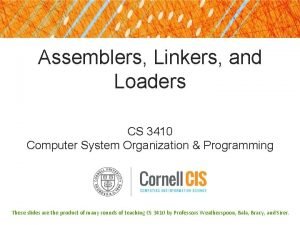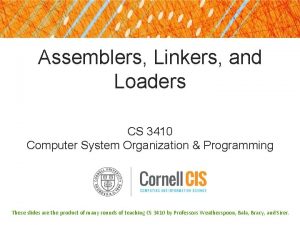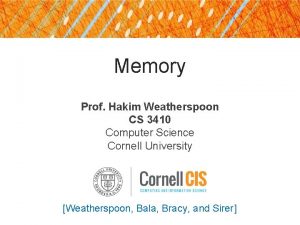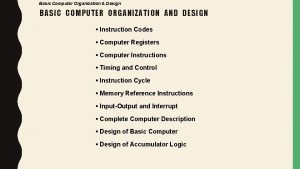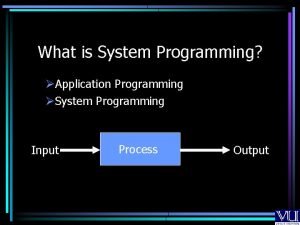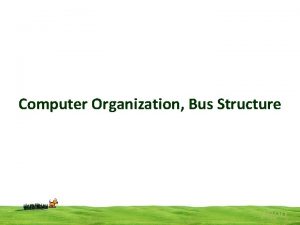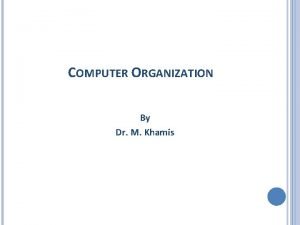CS 3410 Computer System Organization and Programming Prof




















































- Slides: 52

CS 3410: Computer System Organization and Programming Prof. Kavita Bala and Prof. Hakim Weatherspoon CS 3410, Spring 2014 Computer Science Cornell University

Course Objective Bridge the gap between hardware and software • How a processor works • How a computer is organized Establish a foundation for building higher-level applications • How to understand program performance • How to understand where the world is going

Where did it begin? Electrical Switch • On/Off • Binary Transistor The first transistor on a workbench at AT&T Bell Labs in 1947

Moore’s Law 1965 • number of transistors that can be integrated on a die would double every 18 to 24 months (i. e. , grow exponentially with time) Amazingly visionary 2300 transistors, 1 MHz clock (Intel 4004) - 1971 16 Million transistors (Ultra Sparc III) 42 Million transistors, 2 GHz clock (Intel Xeon) – 2001 55 Million transistors, 3 GHz, 130 nm technology, 250 mm 2 die (Intel Pentium 4) – 2004 • 290+ Million transistors, 3 GHz (Intel Core 2 Duo) – 2007 • 721 Million transistors, 2 GHz (Nehalem) - 2009 • 1. 4 Billion transistors, 3. 4 GHz Intel Haswell (Quad core) – 2013 • •


Processor Performance Increase Intel Pentium 4/3000 Intel Xeon/2000 DEC Alpha 21264 A/667 DEC Alpha 5/500 DEC Alpha 21264/600 DEC Alpha 5/300 DEC Alpha 4/266 IBM POWER 100 DEC AXP/500 HP 9000/750 IBM RS 6000 MIPS M 2000 SUN-4/260 MIPS M/120

Moore’s Law 1965 • number of transistors that can be integrated on a die would double every 18 to 24 months (i. e. , grow exponentially with time) Amazingly visionary 2300 transistors, 1 MHz clock (Intel 4004) - 1971 16 Million transistors (Ultra Sparc III) 42 Million transistors, 2 GHz clock (Intel Xeon) – 2001 55 Million transistors, 3 GHz, 130 nm technology, 250 mm 2 die (Intel Pentium 4) – 2004 • 290+ Million transistors, 3 GHz (Intel Core 2 Duo) – 2007 • 721 Million transistors, 2 GHz (Nehalem) - 2009 • 1. 4 Billion transistors, 3. 4 GHz Intel Haswell (Quad core) – 2013 • •

Parallelism CPU: Central Processing Unit

Then and Now http: //techguru 3 d. com/4 th-gen-intel-haswell-processors-architecture-and-lineup/ • The first transistor • An Intel Haswell • One workbench at AT&T Bell Labs • 1947 • Bardeen, Brattain, and Shockley • • • 1. 4 billion transistors 177 square millimeters Four processing cores

Then and Now • The first transistor • Galaxy Note 3 • One workbench at AT&T Bell Labs • 1947 • Bardeen, Brattain, and Shockley • 8 processing cores

Parallelism CPU: Central Processing Unit GPU: Graphics Processing Unit


Supercomputers • Petaflops (1015) – GPUs/multicore/100 s-1000 s cores


Course Objective Bridge the gap between hardware and software • How a processor works • How a computer is organized Establish a foundation for building higher-level applications • How to understand program performance • How to understand where the world is going

How class is organized Instructor: Kavita Bala and Hakim Weatherspoon (kb@cs. cornell. edu, hweather@cs. cornell. edu) Lecture: • Tu/Th 1: 25 -2: 40 • Statler Auditorium Lab sections: • • Start next week Carpenter 104 (Blue room) Carpenter 235 (Red room) Upson B 7 Required Textbooks Suggested Textbook

Who am I? Prof. Kavita Bala • • • Ugrad: IIT Bombay Ph. D: MIT Started in compilers and systems Moved to graphics Also work on parallel processing in graphics


Autodesk 360 Cloud Render

Who am I? Prof. Hakim Weatherspoon • (Hakim means Doctor, wise, or prof. in Arabic) • Background in Education – Undergraduate University of Washington § Played Varsity Football » Some teammates collectively make $100’s of millions » I teach!!! – Graduate University of California, Berkeley § Some class mates collectively make $100’s of millions § I teach!!! • Background in Operating Systems – Peer-to-Peer Storage § Antiquity project - Secure wide-area distributed system § Ocean. Store project – Store your data for 1000 years – Network overlays § Bamboo and Tapestry – Find your data around globe – Tiny OS § Early adopter in 1999, but ultimately chose P 2 P direction

Who am I? Cloud computing/storage • Optimizing a global network of data centers

Course Staff cs 3410 -staff-l@cs. cornell. edu Lab/Homework TA’s • • • • • • Paul Upchurch Zhiming Shen Pu Zhang Andrew Hirsch Emma Kilfoyle Roman Averbukh Lydia Wang Favian Contreras Victoria Wu Detian Shi Maxwell Dergosits Jimmy Zhu Antoine Pourchet Brady Jacobs Kristen Tierney Gary Zibrat Naman Agarwal Sanyukta Inamdar Sean Salmon Ari Karo Brennan Chu <paulu@cs. cornell. edu> <zshen@cs. cornell. edu> <pz 59@cornell. edu> <akh 95@cornell. edu> <efk 23@cornell. edu> <raa 89@cornell. edu> <lw 354@cornell. edu> <fnc 4@cornell. edu> <vw 52@cornell. edu> <ds 629@cornell. edu> <mad 293@cornell. edu> <jhz 22@cornell. edu> <app 63@cornell. edu> <bij 4@cornell. edu> <kjt 54@cornell. edu> <gdz 4@cornell. edu> <na 298@cornell. edu> <sri 7@cornell. edu> <ss 2669@cornell. edu> <aak 82@cornell. edu> <bc 385@cornell. edu> Administrative Assistant: • Molly Trufant (mjt 264@cs. cornell. edu) (Ph. D) (MEng)

Pre-requisites and scheduling CS 2110 is required (Object-Oriented Programming and Data Structures) • Must have satisfactorily completed CS 2110 • Cannot take CS 2110 concurrently with CS 3410 CS 3420 (ECE 3140) (Embedded Systems) • Take either CS 3410 or CS 3420 – both satisfy CS and ECE requirements • However, Need ENGRD 2300 to take CS 3420 CS 3110 (Data Structures and Functional Programming) • Not advised to take CS 3110 and 3410 together

Pre-requisites and scheduling CS 2043 (UNIX Tools and Scripting) • 2 -credit course will greatly help with CS 3410. • Meets Mon, Wed, Fri at 11: 15 am-12: 05 pm in Hollister (HLS) B 14 • Class started yesterday and ends March 5 th CS 2022 (Introduction to C) and CS 2024 (C++) • 1 to 2 -credit course will greatly help with CS 3410 • Unfortunately, offered in the fall, not spring • Instead, we will offer a primer to C during lab sections and include some C questions in homeworks

Schedule (subject to change) Week Date (Tue) Lecture# 1 23 -Jan 28 -Jan 2 Numbers & Arithmetic MIPS Proj 1: MIPS 1 Handout C for Java Programmers RISC & CISC & Prelim 1 Review Prelim 1 C lecture 2 Calling Conventions HW 3: Calling Conventions, RISC, CISC MIPS 2 Proj 2: MIPS 2 Handout Intro to UNIX/Linux Proj 2: Design Doc Due Pipelined MIPS Pipeline Hazards Control Hazards & ISA Variations Proj 1: Design Doc Due 14 H 15 H 18 -Mar Calling Conventions Linkers & and more calling conventions 16 K 17 K Caches 1 Caches 2 25 -Mar ssh, gcc, How to tunnel C lecture 3 18 K H(out) Caches 3 Spring Break 19 H H(out) Spring Break Virtual Memory 1 Stack Smashing Lab 3: Buffer Overflows handout 20 H Virtual Memory 2 Traps Multicore Architectures & GPUs Synchronization HW 4: Virtual memory, Caches, Traps, Multicore, Synchronization Caches Proj 3: Caches Handout Virtual Memory Lab 4: (IN-CLASS) Virtual Memory 15 -Apr 21 H 22 -Apr 22 K 23 K 24 K 25 K|H Synchronization 2 GPUs & Prelim 2 Review 29 -Apr Synchronization Proj 4: Multicore/NW Handout 26 H 27 K&H I/O Future Directions Prelim 2 6 -May Proj 4: Design Doc Due 14 H(out) 13 H 13 8 K 12 H 12 one-week, lab 1 due two-weeks) Lab 2: (IN-CLASS) FSM Handout Winter Break 11 K lab 1: ALU Handout (design doc due FSM H(out) 9 K 8 -Apr 11 ALU/Design Docs 10 K HW 2: FSMs, Memory, CPU, Performance, and pipelined MIPS 1 -Apr 10 CPU Performance & Pipelines 7 K 3 K 11 -Feb 11 -Mar 9 Lab 0: Adder/Logisim intro Handout Logisim Memory Simple CPU 4 -Mar 8 State & FSMs 7 Intro Logic & Gates KB(out) 25 -Feb 6 Lab/Proj KB(out) Lab Topic 5 H 6 K 5 1 K&H 2 H Prelim Evening 4 H 18 -Feb HW 4 -Feb 4 Lecture Topic HW 1: Logic, Gates, Numbers, & Arithmetic 3 Proj 4 Due 13 -May 20 -May

Grading Lab • 5 -6 Individual Labs (50% approx. ) – 2 out-of-class labs (5 -10%) – 3 -4 in-class labs (5 -7. 5%) • 4 Group Projects (30 -35%) • Participation/Quizzes in lab (2. 5%) Lecture • 2 Prelims (50% approx. ) – Dates: March 4, May 1 (35%) • Homework (10%) • Participation/Quizzes in lecture (5%)

Grading Regrade policy • Submit written request to lead TA, and lead TA will pick a different grader • Submit another written request, lead TA will regrade directly • Submit yet another written request for professor to regrade Late Policy • • Each person has a total of four “slip days” Max of two slip days for any individual assignment For projects, slip days are deducted from all partners 25% deducted per day late after slip days are exhausted

Active Learning i. Clicker: Bring to every Lecture Put all devices into Airplane Mode

Active Learning L Deslauriers et al. Science 2011; 332: 862 -864 Published by AAAS Fig. 1 Histogram of 270 physic student scores for the two sections: Experiment w/ quizzes and active learning. Control without.

Active Learning Demo: What year are you in school? a) Freshman b) Sophomore c) Junior d) Senior e) Other

Active Learning Also, activity handouts will be available before class In front of doors before you walk in

Administrivia http: //www. cs. cornell. edu/courses/cs 3410/2014 sp • Office Hours / Consulting Hours • Lecture slides, schedule, and Logisim • CSUG lab access (esp. second half of course) Lab Sections (start next week) T W W R R R F F F 2: 55 – 4: 10 pm 8: 40— 9: 55 am 11: 40 am – 12: 55 pm 3: 35 – 4: 50 pm 7: 30— 8: 45 pm 8: 40 – 9: 55 pm 11: 40 – 12: 55 pm 2: 55 – 4: 10 pm 8: 40 – 9: 55 am 11: 40 am – 12: 55 pm 2: 55 – 4: 10 pm Carpenter Hall 104 (Blue Room) Carpenter Hall 235 (Red Room) Carpenter Hall 104 (Blue Room) Upson B 7 Carpenter Hall 104 (Blue Room) • Labs are separate than lecture and homework • Bring laptop to Labs • Next week: intro to logisim and building an adder

Administrivia http: //www. cs. cornell. edu/courses/cs 3410/2014 sp • Office Hours / Consulting Hours • Lecture slides, schedule, and Logisim • CSUG lab access (esp. second half of course) Course Virtual Machine (VM) • Identical to CSUG Linux machines • Download and use for labs and projects • https: //confluence. cornell. edu/display/coecis/CSUG+Lab+VM+Information

Communication Email • cs 3410 -staff-l@cs. cornell. edu • The email alias goes to me and the TAs, not to whole class Assignments • CMS: http: //cms. csuglab. cornell. edu Newsgroup • http: //www. piazza. com/cornell/spring 2014/cs 3410 • For students i. Clicker • http: //atcsupport. cit. cornell. edu/pollsrvc/

Lab Sections, Projects, and Homeworks Lab Sections start next week • Intro to logisim and building an adder Labs Assignments • Individual • One week to finish (usually Monday to Monday) Projects • two-person teams • Find partner in same section Homeworks • One before each prelim • Will be released a few weeks ahead of time • Finish question after covered in lecture

Academic Integrity All submitted work must be your own • OK to study together, but do not share soln’s • Cite your sources Project groups submit joint work • Same rules apply to projects at the group level • Cannot use of someone else’s soln Closed-book exams, no calculators • Stressed? Tempted? Lost? • Come see us before due date! Plagiarism in any form will not be tolerated

Why do CS Students Need Transistors?

Why do CS Students Need Transistors? Functionality and Performance

Why do CS Students Need Transistors? To be better Computer Scientists and Engineers • • Abstraction: simplifying complexity How is a computer system organized? How do I build it? How do I program it? How do I change it? How does its design/organization effect performance?

Computer System Organization

Computer System Organization Computer System = ? Input + Output + Memory + Datapath + Video Control Keyboard Network Mouse USB Registers bus Serial bus CPU Memory Disk Audio

Compilers & Assemblers C int x = 10; x = 2 * x + 15; r 0 = 0 compiler MIPS assembly language addi r 5, r 0, 10 muli r 5, 2 addi r 5, 15 r 5 = r 0 + 10 r 5 = r 5 * 2 r 5 = r 15 + 15 assembler MIPS machine language op = addi r 0 r 5 10 001000001010000001010 000000010100001000000 001000001010000001111 op = addi r 5 15

Instruction Set Architecture ISA • abstract interface between hardware and the lowest level software • user portion of the instruction set plus the operating system interfaces used by application programmers

Basic Computer System A processor executes instructions • Processor has some internal state in storage elements (registers) A memory holds instructions and data • von Neumann architecture: combined inst and data A bus connects the two regs processor 01010000 10010100 … bus addr, data, r/w memory

How to Design a Simple Processor 10 inst memory 32 register file r 0 2 0 alu 5 5 5 00 pc r 5 new pc calculation control 00: addi 04: muli 08: addi r 5, r 0, 10 r 5, 2 r 5, 15 10

Inside the Processor AMD Barcelona: 4 processor cores Figure from Patterson & Hennesssy, Computer Organization and Design, 4 th Edition

How to Program the Processor: MIPS R 3000 ISA Instruction Categories • • Registers Load/Store Computational Jump and Branch Floating Point R 0 - R 31 PC HI – coprocessor LO • Memory Management OP rs rt OP rd sa immediate jump target funct

Overview Application Operating System Compiler Memory system Firmware Instr. Set Proc. Datapath & Control Digital Design Circuit Design Instruction Set Architecture I/O system

Applications Everything these days! • Phones, cars, televisions, games, computers, …

11 8 2 Applications 1200 1000 2 50 5 29 11 400 5 40 600 0 Xilinx FPGA millions 800 78 5 Cell Phones PCs TVs 93 114 135 202265 136 189 200 0 1997 Cloud Computing 1999 2001 2003 2005 2007 Berkeley mote NVidia GPU Cell Phone Cars 53

Covered in this course Application Operating System Compiler Memory system Firmware Instr. Set Proc. Datapath & Control Digital Design Circuit Design Instruction Set Architecture I/O system

Reflect Why take this course? Basic knowledge needed for all other areas of CS: operating systems, compilers, . . . Levels are not independent hardware design ↔ software design ↔ performance Crossing boundaries is hard but important device drivers Good design techniques abstraction, layering, pipelining, parallel vs. serial, . . . Understand where the world is going
 Nanoprogram
Nanoprogram Process organization in computer organization
Process organization in computer organization Difference between computer organization and architecture
Difference between computer organization and architecture Definition of system programming
Definition of system programming Rfc 3410
Rfc 3410 Cornell cs 3410
Cornell cs 3410 Cornell cs 3410
Cornell cs 3410 Cs 3410
Cs 3410 Cs 3410 cornell
Cs 3410 cornell Cs 3410
Cs 3410 Cs 3410
Cs 3410 Cs 3410
Cs 3410 Basic structure of computer in computer organization
Basic structure of computer in computer organization Design of basic computer
Design of basic computer Fgi and fgo in computer architecture
Fgi and fgo in computer architecture Programming raster display system in computer graphics
Programming raster display system in computer graphics Block organization vs point by point
Block organization vs point by point Explain the components of computer system
Explain the components of computer system What is computer organization
What is computer organization Perbedaan linear programming dan integer programming
Perbedaan linear programming dan integer programming Greedy algorithm vs dynamic programming
Greedy algorithm vs dynamic programming Integer programming vs linear programming
Integer programming vs linear programming Programing adalah
Programing adalah Concepts techniques and models of computer programming
Concepts techniques and models of computer programming Chapter 7 linear programming solutions
Chapter 7 linear programming solutions Computer organization and architecture 10th solution
Computer organization and architecture 10th solution Ripple carry adder virtual lab
Ripple carry adder virtual lab Introduction to computer organization and architecture
Introduction to computer organization and architecture Computer organization & architecture: themes and variations
Computer organization & architecture: themes and variations Computer organization and architecture 10th edition
Computer organization and architecture 10th edition Computer organization and design ppt
Computer organization and design ppt William stallings computer organization and architecture
William stallings computer organization and architecture Computer organisation and architecture
Computer organisation and architecture Computer architecture and organization
Computer architecture and organization Computer architecture and organization
Computer architecture and organization Basic computer design
Basic computer design Neumann dst
Neumann dst System bus in computer
System bus in computer Nocti study guide
Nocti study guide Visual computer programming
Visual computer programming Uil computer science programming problems
Uil computer science programming problems Types of variables in computer programming
Types of variables in computer programming Computerite
Computerite Computer programming chapter 1
Computer programming chapter 1 Tab sequential format
Tab sequential format Susanna s epp
Susanna s epp Computer programming chapter 1
Computer programming chapter 1 Chapter 1 introduction to computers and programming
Chapter 1 introduction to computers and programming Computer programming with matlab
Computer programming with matlab Decision making in computer programming
Decision making in computer programming Computer organization
Computer organization Programming fundamentals 1
Programming fundamentals 1 Python programming an introduction to computer science
Python programming an introduction to computer science




